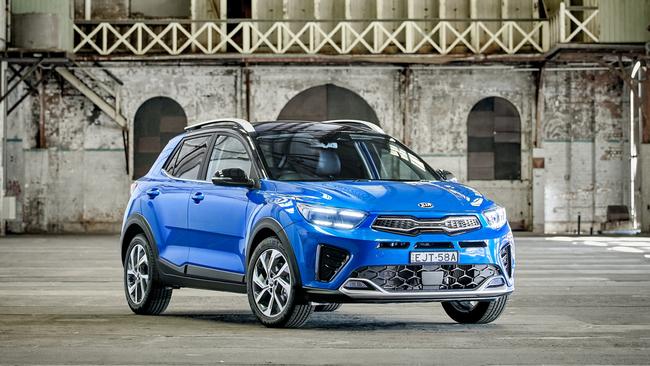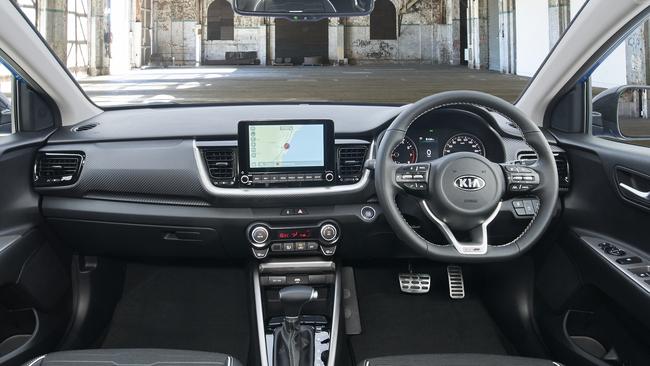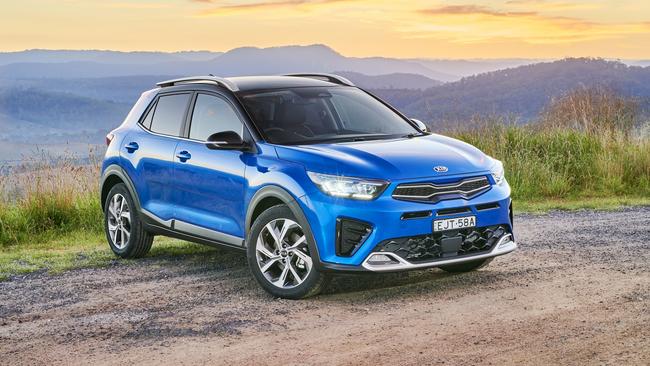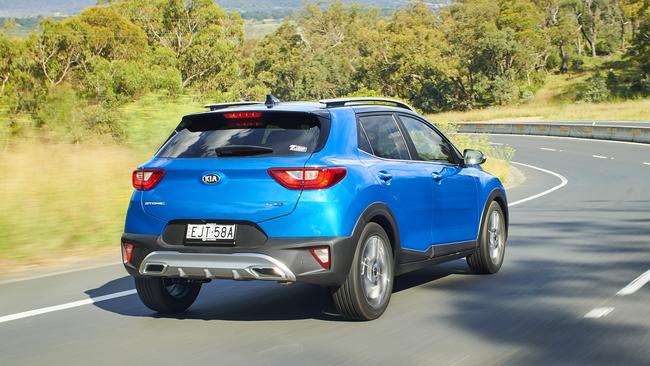Kia Stonic review: Looks above substance for Kia’s new SUV
Attractive and trendy the new SUV will appeal to younger buyers, but the brand has used a sneaky loophole to grab a big safety rating.

New Cars
Don't miss out on the headlines from New Cars. Followed categories will be added to My News.
The Kia Stonic is a crossover for the TikTok generation.
A rebodied version of the Rio city car, the Stonic will be the first Kia promoted to millions of young Australians on the booming social network.
Kia is pitching the SUV to young customers and says the Stonic has “Insta-worthy” looks. It rides 15mm higher than the Rio and looks sharp in the metal, with blocky styling likely to win customer attention.

Priced from $22,990 drive-away in basic manual form (an auto transmission costs an extra $1000), the Stonic is $3500 dearer than its Rio cousin.
Every Stonic gets 17-inch alloy wheels and an 8-inch display with a reversing camera, satnav, Apple CarPlay and Android Auto, but not the Rio’s wireless smartphone mirroring.
A limited safety suite includes lane keeping assistance and auto emergency braking with pedestrian and cyclist detection, but not blind-spot monitoring or active cruise control.
Kia reckons customers will gravitate toward the range-topping Stonic GT-Line that adds a body kit, stiffer suspension, faux leather and carbon interior trim and a turbocharged engine for $29,990 drive-away.

Powered by a 1.0-litre three-cylinder motor driving the front wheels through a seven-speed dual-clutch auto, the GT-Line uses 5.4L/100km of unleaded to make 74kW and 172Nm maximums.
The regular model’s 1.4-litre engine and six-speed auto are less efficient, using 6.7L/100km to make 74kW and 133Nm.
The Stonic follows a well-worn path.

Just as the Mazda CX-3, Volkswagen T-Cross, Honda HR-V and Renault Captur are based on Mazda2, Polo, Jazz and Clio siblings, the Stonic is essentially a reclothed Rio.
A loophole in the ANCAP scoring system allows Kia to sell the Stonic with a five-star safety rating originally offered to the Rio in 2017. Rival models with five-star ratings earned in 2020 have more equipment and passed more stringent tests than the Stonic, which has not been crash-tested.
Kia chief operating officer Damien Meredith says the brand is not being disingenuous by using a four-year-old safety rating for a different car, saying “ANCAP rules sometimes work in your favour and sometimes they don’t”.

Product planner Roland Rivero says many customers are unlikely to look into the fine print behind ANCAP’s ratings, as feedback suggests “five is five — they don’t even look at the year rating”.
Rivero says “we’re not bringing it as an all-new model in contrast to say Sorento and Carnival”. Nevertheless, all three are listed as “all-new” models on Kia’s website.
The Stonic has more boot space than the Rio, though there isn’t any difference in cabin room. Twin USB points and 12-volt power outlets are handy, but modern touches such as wireless charging are absent.
We spent a week with the Stonic GT-Line.
In short, it’s not one of Kia’s best efforts.

The sluggish three-cylinder engine conspires with a grabby dual-clutch auto and grumpy fuel-saving stop-start system to deliver jerky progress around town. The gearbox can hesitate when choosing a gear, occasionally thumping home with an awkward bump.
Kia says the GT-Line’s suspension was “designed to be quite sporty”, with firm responses similar to hot hatchbacks. But the agility of a well-sorted hatchback is absent.
It rides stiffly over bumps and is fidgety on the highway, with an unsettled feel that does not inspire confidence. A wooden-feeling brake pedal and ponderous steering reinforce the suspicion that conventional cars are almost universally better to drive than high-riding cousins.
VERDICT 3/5
Attractive and trendy, the Stonic’s superficial appeal doesn’t hold up to closer scrutiny, as rival machines have more safety gear and are better to drive.
KIA STONIC GT-LINE VITALS
Price: From $29,990 drive-away
Warranty/servicing: 7-year/unlimited km, about $3300 for 7 years
Engine: 1.0-litre 3-cyl turbo petrol, 74kW/172Nm
Safety: Unrated, 6 airbags, auto emergency braking, lane keep assistance
Thirst: 5.4L/100km
Spare: Space saver
Cargo: 352 litres
Originally published as Kia Stonic review: Looks above substance for Kia’s new SUV




